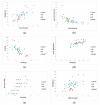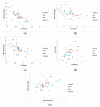Behavioral and Oxidative Stress Changes in Mice Subjected to Combinations of Multiple Stressors Relevant to Irritable Bowel Syndrome
- PMID: 33212821
- PMCID: PMC7698185
- DOI: 10.3390/brainsci10110865
Behavioral and Oxidative Stress Changes in Mice Subjected to Combinations of Multiple Stressors Relevant to Irritable Bowel Syndrome
Abstract
Background and Objectives: Irritable bowel syndrome (IBS) is a well-known functional gastrointestinal (GI) disorder exhibiting a wide range of symptoms due to individual variability and multifactorial etiology. Stress exposure is a major risk factor for the development of IBS. Here, we investigate the differential effects of psychological stress exposures on behavior and oxidative status in mice by using increasingly complex combinations of etiologic IBS-relevant stressors (maternal separation and chronic unpredictable mild stress combinations). Materials and Methods: Mice were subjected to three different combinations of psychological stress factors and subsequent behavioral cognitive and affective parameters and oxidative status markers (superoxide dismutase and glutathione peroxidase antioxidant activity and malondialdehyde level) in the brain and bowel tissues of the animals were analyzed. Results: GI transit modifications reflected by decreased fecal output, cognitive and affective behavioral deficits were observed in all stress exposed groups, but were more evident for the more complex combinations of stressors. Behavioral deficits were accompanied by mild oxidative stress occurring in the bowel and to a greater extent in brain tissue. Conclusions: The presented data depict the effect of various associations in mimicking IBS symptoms and comorbidities and suggest that an all-inclusive combination of early and adult-life psychological stressors is more effective in IBS symptoms modulation. Oxidative stress in both brain and bowel, suggestive for brain-gut molecular connectivity, may play an important role in IBS mechanistic.
Keywords: behavioral tasks; chronic unpredictable mild stress; irritable bowel syndrome; mice; neonatal maternal separation; oxidative stress; restraint stress.
Conflict of interest statement
None, except for the two research grants mentioned above.
Figures











Similar articles
-
Preliminary Biochemical Description of Brain Oxidative Stress Status in Irritable Bowel Syndrome Contention-Stress Rat Model.Medicina (Kaunas). 2019 Dec 6;55(12):776. doi: 10.3390/medicina55120776. Medicina (Kaunas). 2019. PMID: 31817740 Free PMC article.
-
Irritable Bowel Syndrome and Neurological Deficiencies: Is There A Relationship? The Possible Relevance of the Oxidative Stress Status.Medicina (Kaunas). 2020 Apr 13;56(4):175. doi: 10.3390/medicina56040175. Medicina (Kaunas). 2020. PMID: 32295083 Free PMC article. Review.
-
Neuronal Nitric Oxide Synthase Is a Novel Biomarker for the Interstitial Cells of Cajal in Stress-Induced Diarrhea-Dominant Irritable Bowel Syndrome.Dig Dis Sci. 2018 Mar;63(3):619-627. doi: 10.1007/s10620-018-4933-7. Epub 2018 Jan 25. Dig Dis Sci. 2018. PMID: 29372479
-
Inflammatory cytokines and oxidative stress biomarkers in irritable bowel syndrome: Association with digestive symptoms and quality of life.Cytokine. 2017 May;93:34-43. doi: 10.1016/j.cyto.2017.05.005. Epub 2017 May 12. Cytokine. 2017. PMID: 28506572 Clinical Trial.
-
Endocrine regulation of gut function - a role for glucagon-like peptide-1 in the pathophysiology of irritable bowel syndrome.Exp Physiol. 2019 Jan;104(1):3-10. doi: 10.1113/EP087443. Epub 2018 Dec 10. Exp Physiol. 2019. PMID: 30444291 Review.
Cited by
-
Anxiolytic Effect of Carvedilol in Chronic Unpredictable Stress Model.Oxid Med Cell Longev. 2022 Aug 19;2022:6906722. doi: 10.1155/2022/6906722. eCollection 2022. Oxid Med Cell Longev. 2022. PMID: 36035219 Free PMC article.
-
Potential Roles of Enterochromaffin Cells in Early Life Stress-Induced Irritable Bowel Syndrome.Front Cell Neurosci. 2022 Mar 15;16:837166. doi: 10.3389/fncel.2022.837166. eCollection 2022. Front Cell Neurosci. 2022. PMID: 35370559 Free PMC article. Review.
-
CENTRAL AND PERIPHERAL EFFECT OF MPTP VIA DOSE-DEPENDENT MAGNESIUM MODULATION.Acta Endocrinol (Buchar). 2023 Jan-Mar;19(1):36-48. doi: 10.4183/aeb.2023.36. Epub 2023 Aug 14. Acta Endocrinol (Buchar). 2023. PMID: 37601708 Free PMC article.
-
Systemic inflammation in the pathogenesis of irritable bowel syndrome associated with obesity.J Med Life. 2021 Jul-Aug;14(4):531-535. doi: 10.25122/jml-2021-0120. J Med Life. 2021. PMID: 34621378 Free PMC article.
-
Sinisan Alleviates Stress-Induced Intestinal Dysfunction and Depressive-like Behaviors in Mice with Irritable Bowel Syndrome by Enhancing the Intestinal Barrier and Modulating Central 5-Hydroxytryptamine.Int J Mol Sci. 2024 Sep 24;25(19):10262. doi: 10.3390/ijms251910262. Int J Mol Sci. 2024. PMID: 39408592 Free PMC article.
References
-
- Bradesi S., Golovatscka V., Ennes H.S., McRoberts J.A., Karagiannidis I., Bakirtzi K., Pothoulakis C., Mayer E.A. Role of astrocytes and altered regulation of spinal glutamatergic neurotransmission in stress-induced visceral hyperalgesia in rats. Am. J. Physiol. Liver Physiol. 2011;301:G580–G589. doi: 10.1152/ajpgi.00182.2011. - DOI - PMC - PubMed
Grants and funding
LinkOut - more resources
Full Text Sources

